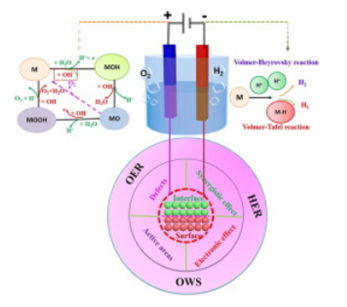Welcome to College of Chemistry, Chemical Engineering and Materials Science of Soochow
University
Surface and interface engineering of noble-metal-free electrocatalysts for efficient overall water splitting
Hui Xu, Hongyuan Shang, Cheng Wang, Yukou Du*(杜玉扣)
College of Chemistry, Chemical Engineering and Materials Science, Soochow University, Suzhou 215123, PR China
Coordination Chemistry Reviews 418 (2020) 213374
Developing highly efficient overall water splitting (OWS) electrocatalysts based on noble-metal-free materials to produce fuel is stimulated by increasing concerns regarding global energy security and environment contamination. Tremendous accomplishments in the design and fabrication of non-noble metal counterpart to substitute the noble metal catalysts for efficient oxygen evolution reaction (OER), hydrogen evolution reaction (HER), and OWS are boosting the development of clean hydrogen fuel production. Recent researches and advances reveal that the surface and interface atomic engineering can readily induce novel physiochemical properties, such as more surface active sites, electronic effect, and strong synergistic effect, offering new and efficient avenues toward largely promoted electrocatalytic performance. In this review, we focus on the recent progress in designing and constructing highperformance non-noble metal catalysts for efficient OER, HER, and OWS through surface and interface engineering. A few of surface and interface effects have been highlighted to account for the influence of electrocatalytic properties observed in catalysts. And a series of the surface and interface engineering strategies have been utilized in non-noble metal counterparts design, including traditional chemical method (e.g. wet-chemical, hydrothermal/annealing), deposition (chemical/electrochemical deposition), and in-situ electrochemical oxidation strategy. The rational design of noble-metal-free counterparts with excellent electrocatalytic performance based on surface and interface engineering could realize improved electrocatalysis, offering a deep understanding of structure–activity relationships.

链接:https://www.sciencedirect.com/science/article/pii/S0010854520300813